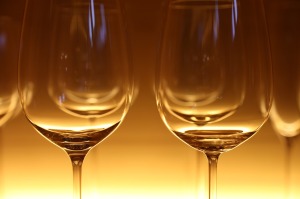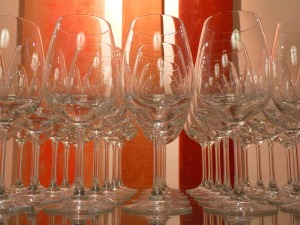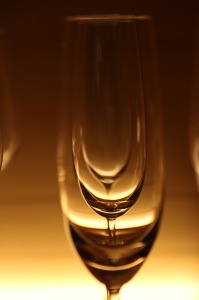There are a lot of wine accessories and contraptions out there. It can be tough to tell which ones are just a waste of money, and which can really enhance your wine-drinking experience. One thing that’s not a gimmick? The idea that different wines should have different glasses.
 Now, there is certainly nothing wrong with having just the standard four varieties of glasses: red wine, white wine, sweet and champagne. But having specific glasses for different grape varieties, styles, and even ages of wines can really make a difference in your tasting experience. The right glass can bring out nuances of flavor and aroma that your standard tasting glass wouldn’t.
Now, there is certainly nothing wrong with having just the standard four varieties of glasses: red wine, white wine, sweet and champagne. But having specific glasses for different grape varieties, styles, and even ages of wines can really make a difference in your tasting experience. The right glass can bring out nuances of flavor and aroma that your standard tasting glass wouldn’t.
Things you need to determine
• Which glass sizes emphasize the appropriate aromas in different wines
• Which shapes and sizes exhibit the appropriate fruitiness levels
• Which shapes and sizes exhibit the appropriate tannin levels
• Which shapes direct wines to the “right” part of the tongue
 The ability of any wine glass to obtain any of these qualities should be taken with a grain of salt. For example, the idea of a “tongue map,” or that specific parts of the tongue taste specific flavors, isn’t supported by science (but we’ll save a discussion of this issue for a future post). But the size and shape of the bowl, at least in the opinions of many experts, can definitely influence the way you perceive the flavor, aroma, and mouthfeel of the wine.
The ability of any wine glass to obtain any of these qualities should be taken with a grain of salt. For example, the idea of a “tongue map,” or that specific parts of the tongue taste specific flavors, isn’t supported by science (but we’ll save a discussion of this issue for a future post). But the size and shape of the bowl, at least in the opinions of many experts, can definitely influence the way you perceive the flavor, aroma, and mouthfeel of the wine.
For the average wine drinker, buying an entire collection of glasses–a set for each kind of wine–seems too overwhelming, let alone expensive. But no fear–you can still match the appropriate glass to the wine without breaking the bank. Here are some basic guidelines for matching glasses with wines that can help you get the most enjoyment out of your wine:
 For white wines:
For white wines:
- Use a glass with a narrower bowl. This keeps the surface area, or the amount of wine exposed to the air, at a minimum, so that it stays chilled longer. White wines taste best and have the most aromatic bouquets when chilled to the appropriate temperature.
- The opening of the glass should also be narrower. A narrow bowl keeps the subtler aromas of white wine more concentrated, so that when you waft them towards your nose, they don’t dissipate as much, and are detectable.
- For lighter wines like Pinot Grigio and Riesling, use a glass with a narrower bowl and a narrower opening. (These wines should have limited exposure to oxygen so that they maintain their subtle flavors.)
- For more flavorful whites, such as Chardonnay and Sauvignon Blanc, use a glass with a slightly fuller bowl that narrows towards the opening. (These wines benefit from the aeration provided by the fuller bowl–it helps bring out their flavors. Both lighter and more flavorful whites need a narrow opening to help keep them chilled and aid in wafting.)
For red wines:
- Use a glass with a wide bowl to let the wine breathe. The exposure to oxygen will mellow the tannins and bring out the bold flavors of red wine. A wide bowl also allows the aromas to collect, giving you the maximum opportunity to sense them.
- Use a glass with a wider opening. Besides allowing more air to come in, a wider opening allows room for your to dip your nose right inside the glass for a proper tasting.
Tips
 Always fill glasses one-third full. This makes sure oxygen can get in, and leaves you room to swirl the wine, with helps it release aromas for you to enjoy.
Always fill glasses one-third full. This makes sure oxygen can get in, and leaves you room to swirl the wine, with helps it release aromas for you to enjoy.- It’s best to wash wine glasses with very hot water only–if you have to use detergent, limit yourself to a few drops. Soap causes buildup in your glasses that interferes with the tastes of the wine.
Investing in a collection of wine glasses suited to many different types of wine is a big decision. But it’s no gimmick: in wine tasting, size and shape really do matter.
Get yourself a good wine glass and you’ll realize how great your life is with a glass pf wine.



 0
0